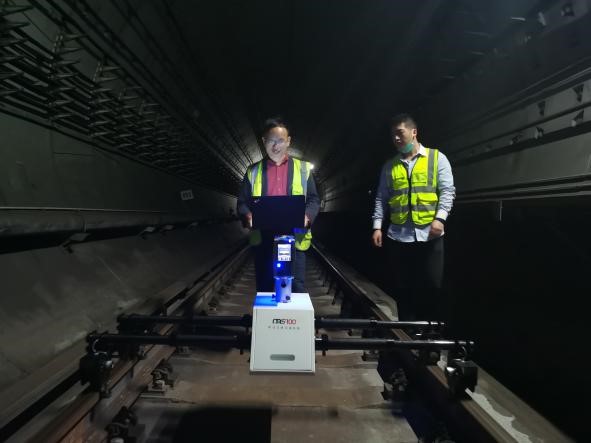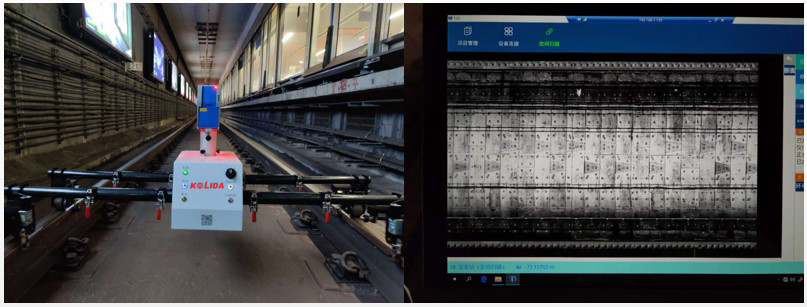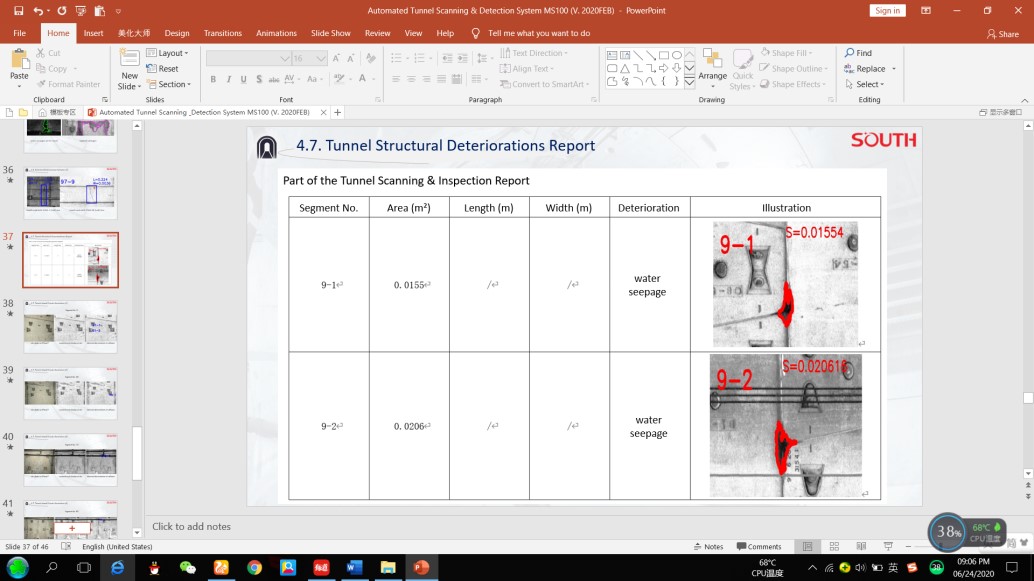2020-08-12
Automated Scanning Challenges Harsh Underground Environment. The quality metro service results from proper maintenance of the subway facilities and environments. Upon official operation of a metro line, the administrative department will have to conduct routine inspection at regular intervals or have it done by a third-party organization. “The tunnel deformation might have a direct impact on a series of ride safety factors like sectional clearance, track gauge, electricity supply, longitudinal slope curvature, etc. and what’s more, its structural failure will lead to differential settlement, convergence deformation, water seepage, segment breakage and so on. A periodical overall checkup is a must to find out such tunnel defects, or say diseases, otherwise the metro operational performance and safety remains an uncertain issue.” Mr. Zhipeng Zeng, a smart engineer who has been focusing on tunnel engineering for years, explained with his own understandings. Sergey, the old man in the film, was one of the team responsible for regular inspection of the metro tunnel (see Fig. 1). Basically speaking, such staff need to move inside the tunnel on foot, look here and there and take photos if necessary. Dim site, poor ventilation, dark trenches, dusty air and uneven path all contribute to their harsh job environment, yet the off-work stoppage during operation stage is quite short, typically less than 4 hours. As a matter of fact, the acquired information could be very limited from both oral reports and site notes. “What if Old Sergey worked with our MS100? Abundant analysis reports come out just within a few hours, and do you think the management would believe his words or prefer something black&white?” Engr. Zhipeng smiled and added. The Automated Tunnel Scanning & Detection System (see Fig. 2), consisted of motorized trolley platform TrolleyAuto, all-in-one software Tunnel Scan&Go and Faro 3D laser scanner, was designed for fully automated and incredibly fast data capture by one-key start click. Jobs could be really easier in the underground scenes than ever. | ||
|  | |
Fig. 1, Sergey found something wrong while inspecting | Fig. 2, motorized trolley running on tracks to go scanning | |
Realtime Output Makes Immediate Response Possible. Tunnel features narrow space while lots of passengers and facilities are involved. When a disaster comes, escape and rescue works are considerably difficult (see Fig. 3). The lesson at cost of human lives in the movie taught us to do things beforehand, as safety is always priority. The inspection team is expected to notice every single detail and submit timely reports, but the old methodology suffers complicated personnel handover and data process. The comparably slow work pace and technological lags somehow give birth to certain hidden troubles. Now this new solution would definitely amaze all practitioners because the fundamental data with almost dead-zone free could be generated while scanning in progress (see Fig. 4). Realtime output! Mapping on site! It’s really awesome, isn’t it? The high-resolution photo and computer vision help to perfectly present what the tunnel inwall structure is like. | ||
|
| |
| Fig. 3, disaster came all of a sudden in the confined space | Fig. 4, fast scanning and mapping on site | |
“Let’s say, you take 2mm resolution for a 1km inspection task. Start at 1 am and finish scanning around 2:30 am, then you get the basic output orthophoto right away on site. Go back to office, compute and analyze the data, and the software will present you the final report by demonstrating nearly all tunnel defects within minutes. The front-end data process is a typical advantage of the all-in-one software Tunnel Scan&Go. In other words, the high-quality results (see Fig. 5) that 3D laser scanning delivers show all good or bad of the tunnel inwalls. Had it been for such abundant outputs, the officers-in-charge would have paid more attention to what the drunkard Sergey mentioned.” Engr. Hongwei, who is in charge of R&D department, told us. Nevertheless, that tunnel was doomed to go through a disaster because it was indeed a disastrous film. For the best word of mouth and box office, the film director presented us a big feast of visual impacts from numerous fast-forward scenes. However, nobody would like to experience the tragedy. Life doesn’t come easy, and it’s assumed that accident, or tomorrow, is just a matter of how the tunnel has been inspected this evening. | ||
 | ||
| Fig. 5, realtime outputting circular orthophoto while trolley moving | ||
Scan Every Single Corner in All Types of Tunnel Environment. This movie described not only disasters but also humanity, which makes it a tear-jerking and soul-crushing masterpiece. Natural disasters are actually unpredictable, yet man-made calamities could be under control. If Sergey were not considered as a drunkard, his oral reports would not be misjudged as nonsense. If the officers-in-charge did not neglect their duties, the metro service would have been suspended right away and the tunnel would have gone into rush repairs. If the water seepage were paid enough attention to, the accident would not have turned into a heart-stopping and gut-wrenching disaster… But there is no if, especially in reality. Safe operation of any public transportation is always prior to comfortable ride and travelling convenience, so every single detail matters. The old methodology, either manual inspection or total station survey, just delivers limited outputs. When complete information is needed, a combination of different methodologies shall be considered and then the job might run into a complex one. In this case, it’s great to have MS100 that provides structural data analysis (eg. segment faulting, clearance, convergence, limit, etc. see Fig. 6 & 7) and detects the majority of inwall diseases (eg. water seepage, lining cracking, segment damage, concrete peeling or falling-off, etc. see Fig. 8 & 9). It’s somewhat like a complete body checkup for the tunnel by smart algorithm based on artificial intelligence. Moreover, this software-driven solution fits all types of underground tunnel environment such as shield tunnel, bored tunnel, open-cut to shield structure part, and open-cut structure metro station. | ||
|
| |
| Fig. 6, tunnel limit analysis | Fig. 7, tunnel clearance analysis | |
|
| |
| Fig. 8, detected water seepage example | Fig. 9, detected inwall crack example | |
Do Exactly What Rail Authorities Need Most. This Russian film was fairly dramatic and thought-provoking (see Fig. 10). Without countless breathtaking lens effects in Hollywood movies and romantic but bitter love in Korean idol dramas, the plots that twist and turn still go directly to the heart of people with good and evil of human nature. It’s all about those several emotional clues, especially the dramatic conflict between family affection and love view of the hero Andrew, the sublimated true love that withstood misfortune between the young tour guide and beautiful charming girl, the fat mailman’s deep sweet love towards his wife… A successful film that enjoys both word of mouth and box office must be mindful of how audience are touched. Then, in the commercial world, suppliers must also understand what their users really need. To the rail authority, laser scanning and algorithm computation are simply approaches, yet they care more about detecting the tunnel defects and finding out those hidden troubles. “Staff of rail authority or the third-party inspection organization might not be specializing in precise measurement in particular. With MS100, operators are not required to be skillful in 3D laser scanning and other survey knowledge even. What makes it interesting is that users may go straight to the final reports after fieldwork instead of importing the scanned results into third-party software for further computation. The all-in-one software Tunnel Scan&Go includes automated scanning, data process, smart analysis, intelligent detection and report export (see Fig. 11). With a single software kit, users may enjoy one-stop service for all necessary information!” Engr. Zhipeng emphasized. To achieve such deep understanding, the R&D team have invested tremendous efforts in the actual workflow and product appeal. That’s to say, the functions on users’ mind is what a sound solution shall include. But, how to collect and interpret such ultimate demands of the rail authority? It’s all because South Group has been taking part in a good many tunnel engineering projects and accumulating a lot of job experience. When the manufacturer stands on the position of their users, the solutions tailored to site requirements could be really more logical and practical. | ||
|  | |
| Fig. 10, a though-provoking tragedy of tunnel collapse | Fig. 11, data analysis and detected results in report list | |
Millimeter-level Accuracy. No Headache About Data Mosaic at All. A collapsed tunnel might be rebuilt but history would never repeat itself. When disaster strikes, human beings are so tiny and life is too fragile. Instead of investigating thoroughly the causes and affixing the responsibility to someone after the disaster, the authorities might as well invest more in the routine maintenance just to minimize the accident rate. Tunnel does have life, and we need to take good care of it by timely checkup and effective treatments. A miss is as good as a mile, as the proverb goes. A slight error in the metro tunnel could be inacceptable because there are tens of thousands of passengers taking the subway every day. As a result, the rail authorities attach great importance to tunnel inspection data and its accuracy effect. Terrestrial laser scanning (see Fig. 12) has been utilized more and more in recent years. Though it’s much better than the old methodologies, unequally distributed point cloud and inevitable occlusions caused by visual troubles would provide unsatisfactory outcome. Moreover, error transfer and accumulation from repeated station movements add another issue. “When MS100 is in use, all of such headaches are gone because the motorized trolley would be running on the rail tracks. Full automation results in no station movement and data mosaic. The adaptive cruise control of the motorized trolley provides the best visual angle to obtain high quality point cloud and achieve millimeter level accuracy! Then, all inspected results could be more reliable in this case. For example, when 2mm resolution is selected before mission, you may expect to find out those cracks with 5cm x 0.3mm (LxW) or above. For your information, laser scanning solution based on hand-push trolley is also available on the market, yet keeping steady movement and even speed would be a big challenge to guarantee high resolution results. However, our MS100 has revolutionized the way that it used to be, and the biggest change is a perfect integration of automated scanning and mobile mapping (see Fig. 13). The high-resolution circular photo plus high-quality point cloud with even alignment will absolutely help to detect the problematic portions much more easily.” Engr. Hongwei continued to tell their magic. | ||
|
| |
| Fig. 12, terrestrial laser scanning mounted on a tripod | Fig. 13, automated scanning and mobile mapping for tunnel inspection | |